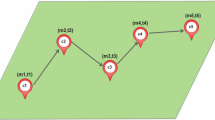Abstract
Human mobility has attracted lots of attention in the domain of wireless communication technologies and behavioral sciences. Exploring and analyzing human movements that are changing over time, relating to user habits and depending on spacial aspect is a challenging problem. In this paper, we are interested in discovering communities of mobile users and studying how do communities provide accurate knowledge to analysis the different forms of human mobility. The basic idea of our work is to model the behaviour of users with strong social characteristics regarding the context of their location histories to explore a similar interest of people by mining their mobiles communities. The proposed analysis illustrates in what way a common interest of a group of individuals can create better understanding of human mobility. Realistic models based on these interest based communities can be the basis for applications as recommendation system or wireless networks management.










Similar content being viewed by others
References
Aggarwal CC, Procopiuc C, Yu PS (2002) Finding localized associations in market basket data. IEEE Trans Knowl Data Eng 14(1):51–62
Agrawal R, Imieliński T, Swami A Mining association rules between sets of items in large databases Acm sigmod record, vol 22. ACM, pp 207–216
Barabàsi AL (2003) Linked: The new science of networks
Baraldi AN, Enders CK (2010) An introduction to modern missing data analyses. J Sch Psychol 48(1):5–37
Boccaletti S, Latora V, Moreno Y, Chavez M, Hwang D-U (2006) Complex networks: Structure and dynamics. Phys Rep 424(4):175–308
Cao H, Mamoulis H, Cheung DW (2005) Mining frequent spatio-temporal sequential patterns Fifth IEEE International Conference on Data Mining (ICDM’05). IEEE, pp 8–pp
Chen L, Lv M, Chen G (2010) A system for destination and future route prediction based on trajectory mining
Ester M, Kriegel H-P, Sander J, Xu X et al A density-based algorithm for discovering clusters in large spatial databases with noise Kdd, vol 96, pp 226–231
Fang H, Hsu W-J, Rudolph L (2009) Mining user position log for construction of personalized activity map International Conference on Advanced Data Mining and Applications. Springer, pp 444–452
Flake GW, Lawrence S, Giles CL, Coetzee FM (2002) Self-organization and identification of web communities. Computer 35(3):66–70
Fortunato S Community detection in graphs 486(3):75–174
Girvan M, Newman MEJ Community structure in social and biological networks 99(12):7821–7826
Gonzalez MC, Hidalgo CA, Barabasi A-L Understanding individual human mobility patterns 453(7196):779–782
Guimera R, Nunes Amaral LA Functional cartography of complex metabolic networks 433(7028):895–900
Han J, Pei J, Yin Y, Mao R Mining frequent patterns without candidate generation: A frequent-pattern tree approach 8(1):53– 87
Krause AE, Frank KA, Mason DM, Ulanowicz RE, Taylor WW (2003) Compartments revealed in food-web structure. Nature 426(6964):282–285
Li Q, Zheng Y, Xie X, Chen Y, Liu W, Ma W-Y (2008) Mining user similarity based on location history Proceedings of the 16th ACM SIGSPATIAL international conference on Advances in geographic information systems, vol 34. ACM
Lusseau D, Newman MEJ (2004) Identifying the role that animals play in their social networks. Proc R Soc Lond B Biol Sci 271(Suppl 6):S477–S481
Nanni M, Pedreschi D (2006) Time-focused clustering of trajectories of moving objects. J Intell Inf Syst 27(3):267–289
Newman M Networks: an introduction. Oxford university press
Newman MEJ (2003) Mixing patterns in networks, physical review E. 67:026126
Newmanm MEJ, Girvan M (2004) Finding and evaluating community structure in networks 69(2):026113
Nexus MB Small Worlds and the Groundbreaking Science of Networks. Norton Publishing
Palla G, Derényi I, Farkas I, Vicsek T (2005) Uncovering the overlapping community structure of complex networks in nature and society. Nature 435(7043):814–818
Papandrea M, Jahromi KK, Zignani M, Gaito S, Giordano S, Rossi GP (2016) On the properties of human mobility. Comput Commun 87:19–36
Papandrea M, Zignani M, Gaito S, Giordano S, Rossi GP (2013) How many places do you visit a day? 2013 IEEE International Conference on Pervasive Computing and Communications Workshops (PERCOM Workshops). IEEE, pp 218–223
Pimm SL (1979) The structure of food webs. Theor Popul Biol 16(2):144–158
Radicchi F, Castellano C, Cecconi F, Loreto V, Parisi D Defining and identifying communities in networks 101(9):2658– 2663
Rhee I, Shin M, Hong S, Lee K, Kim S, Chong S (2009) Crawdad data set ncsu/mobility models
Song C, Qu Z, Blumm N, Barabási A-L (2010) Limits of predictability in human mobility. Science 327(5968):1018–1021
Sorensen C, Mathiassen L, Kakihara M Mobile services: Functional diversity and overload
Vincenty T (1975) Direct and inverse solutions of geodesics on the ellipsoid with application of nested equations. Surv Rev 23(176):88–93
Zaki MJ (2000) Scalable algorithms for association mining. IEEE Trans Knowl Data Eng 12(3):372–390
Zheng Y GeoLife GPS trajectories
Zheng Y Location-based social networks: Users Computing with spatial trajectories. Springer, pp 243–276
Zheng Y, Li Q, Chen Y, Xie X, Ma W-Y Understanding mobility based on GPS data Proceedings of the 10th international conference on Ubiquitous computing. ACM, pp 312–321
Zheng Y, Xie X (2011) Learning travel recommendations from user-generated GPS traces. ACM Trans Intell Syst Technol (TIST) 2(1):2
Zheng Y, Xie X, Ma W-Y (2010) GeoLife: A collaborative social networking service among user, location and trajectory. IEEE Data Eng Bull, 33(2):3239
Zheng Y, Zhang L, Xie X, Ma W-Y Mining interesting locations and travel sequences from GPS trajectories Proceedings of the 18th international conference on World wide web. ACM, pp 791–800
Zhou H (2003) Distance, dissimilarity index, and network community structure. Phys Rev E 67(6):061901
Zimmermann M, Kirste T, Spiliopoulou M Finding stops in error-prone trajectories of moving objects with time-based clustering Intelligent interactive assistance and mobile multimedia computing. Springer, pp 275–286
Author information
Authors and Affiliations
Corresponding author
Rights and permissions
About this article
Cite this article
Drif, A., Boukerram, A., Slimani, Y. et al. Discovering Interest Based Mobile Communities. Mobile Netw Appl 22, 344–355 (2017). https://doi.org/10.1007/s11036-017-0811-3
Published:
Issue Date:
DOI: https://doi.org/10.1007/s11036-017-0811-3




